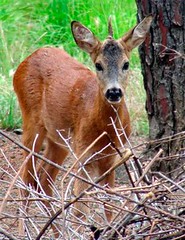ROME (AP) — A deer with a single horn in the center of its head — much like the fabled, mythical unicorn — has been spotted in a nature preserve in Italy, park officials said Wednesday.
"This is fantasy becoming reality," Gilberto Tozzi, director of the Center of Natural Sciences in Prato, told The Associated Press. "The unicorn has always been a mythological animal."
The 1-year-old Roe Deer — nicknamed "Unicorn" — was born in captivity in the research center's park in the Tuscan town of Prato, near Florence, Tozzi said.
He is believed to have been born with a genetic flaw; his twin has two horns.
Here's the thing: This isn't a big deal. The growth mechanism of antlers is poorly understood at best, and gives rise to all sorts of bizarre and counter-intuitive growth patterns. For instance, when an antler is growing--"in velvet" as it were--the bone tissue is soft and covered in a fine, velvety covering rich in blood vessels. Antlers are, essentially, annual bone growth which is shed following rut only to begin the process anew. Since the velvet antlers are soft, they are easily damaged and somewhat susceptible in infections and the like, which can cause odd, asymmetrical and/or downright surreal growth patterns that deviate far from the norm. We know from our old buddy Mendel that injuries or physical trauma sustained by an animal or plant isn't passed on to future generations, since such afflictions don't extend to the genetic level. One would expect this to hold true for antler growth, since the afflicted antler is shed and an entirely new one is regrown the following year. One would think. Strangely enough, this isn't always the case, and new antlers can show signs of that same trauma in subsequent years.
If you think that's strange, try this on for size: Physical injury to a deer's legs can manifest in antler growth. Deer aren't like horses--they can break a leg and survive, although the odds of doing so aren't great. But if a deer, hypothetically breaks it's right hind leg, it's the left antler that would be affected. And, like the trauma sustained by an antler directly, trauma sustained by a leg can manifest in subsequent years' antler growth. Crazy stuff, man.
I don't know a lot, specifically, regarding the roe deer itself. It's a smallish species with relatively tiny two- or three-pronged antlers, so it's not a popular game animal for either meat or trophies. The antlers grow from bony knobs on the top of the skull called pedicles, and in roe deer these are somewhat closer together than in other species. In older bucks, the base of the antlers can actually grow together to for a solid, knobby mass with the individual antlers projecting up from. Because of this, if ever there was a candidate deer species to have a single antler jutting up from the center of the skull, roe deer would be my choice. That photo above could easily be Photoshopped, although I have no reason to believe it's not real.
I do have reason to believe the reporter who wrote the original piece was a moron, however. Deer have antlers, which when mature, are non-living bone. Antlers are shed and re-grown annually. Deer do not have horns, which are keratin sheaths over a core of living bone. Horns are not shed, and generally grow throughout an animal's life. That is the end of today's lesson. Class dismissed.
Now Playing: SixMileBridge Across the Water


Schmendrick would be so proud. But wouldn't this be the *first* unicorn?
ReplyDelete